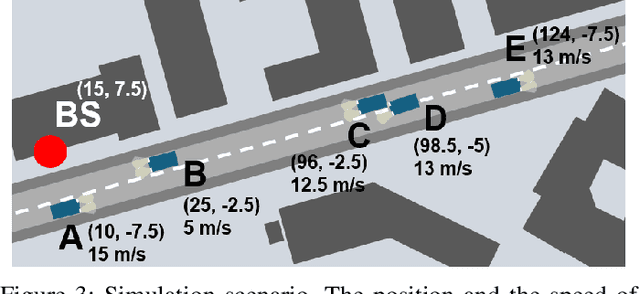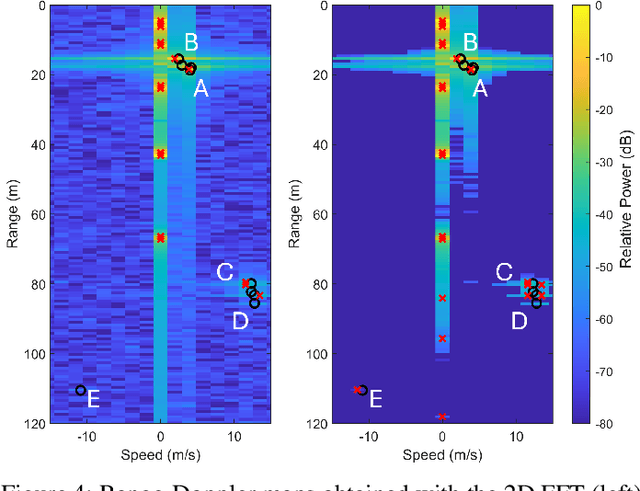Pradyumna Kumar Bishoyi
Optimal Weight Scheme for Fusion-Assisted Cooperative Multi-Monostatic Object Localization in 6G Networks
Aug 29, 2024Abstract:Cooperative multi-monostatic sensing enables accurate positioning of passive targets by combining the sensed environment of multiple base stations (BS). In this work, we propose a novel fusion algorithm that optimally finds the weight to combine the time-of-arrival (ToA) and angle-of-arrival (AoA) likelihood probability density function (PDF) of multiple BSs. In particular, we employ a log-linear pooling function that fuses all BSs' PDFs using a weighted geometric average. We formulated an optimization problem that minimizes the Reverse Kullback Leibler Divergence (RKLD) and proposed an iterative algorithm based on the Monte Carlo importance sampling (MCIS) approach to obtain the optimal fusion weights. Numerical results verify that our proposed fusion scheme with optimal weights outperforms the existing benchmark in terms of positioning accuracy in both unbiased (line-of-sight only) and biased (multipath-rich environment) scenarios.
Empowering 5G PRS-Based ISAC with Compressed Sensing
Jul 18, 2024



Abstract:To enable widespread use of Integrated Sensing and Communication (ISAC) in future communication systems, an important requirement is the ease of integration. A possible way to achieve this is to use existing communication reference signals for sensing, such as the 5G Positioning Reference Signal (PRS). Existing works have demonstrated promising results by using the PRS with classical signal processing techniques. However, this approach suffers from a loss of SNR due to the sparse resource allocation. In this work, we improve upon existing results by combining the 5G PRS with compressed sensing methods. We demonstrate that our method achieves better noise robustness compared to the existing works and has superresolution properties, making it an ideal choice for range-Doppler map generation and target detection even in noisy environments.
Power Allocation Scheme for Device-Free Localization in 6G ISAC Networks
Feb 16, 2024Abstract:Integrated Sensing and Communication (ISAC) is considered one of the crucial technologies in the upcoming sixth-generation (6G) mobile communication systems that could facilitate ultra-precise positioning of passive and active targets and extremely high data rates through spectrum coexistence and hardware sharing. Such an ISAC network offers a lot of benefits, but comes with the challenge of managing the mutual interference between the sensing and communication services. In this paper, we investigate the problem of localization accuracy in a monostatic ISAC network under consideration of inter-BS interference due to communication signal and sensing echoes, and self-interference at the respective BS. We propose a power allocation algorithm that minimizes BS's maximum range estimate error while considering minimum communication signal-to-interference-plus-noise ratio (SINR) and total power constraint. Our numerical results demonstrate the effectiveness of the proposed algorithm and indicate that it can enhance the sensing performance when the self-interference is effectively suppressed.
Cooperative Multi-Monostatic Sensing for Object Localization in 6G Networks
Nov 24, 2023Abstract:Enabling passive sensing of the environment using cellular base stations (BSs) will be one of the disruptive features of the sixth-generation (6G) networks. However, accurate localization and positioning of objects are challenging to achieve as multipath significantly degrades the reflected echos. Existing localization techniques perform well under the assumption of large bandwidth available but perform poorly in bandwidth-limited scenarios. To alleviate this problem, in this work, we introduce a 5G New Radio (NR)-based cooperative multi-monostatic sensing framework for passive target localization that operates in the Frequency Range 1 (FR1) band. We propose a novel fusion-based estimation process that can mitigate the effect of multipath by assigning appropriate weight to the range estimation of each BS. Extensive simulation results using ray-tracing demonstrate the efficacy of the proposed multi-sensing framework in bandwidth-limited scenarios.
 Add to Chrome
Add to Chrome Add to Firefox
Add to Firefox Add to Edge
Add to Edge